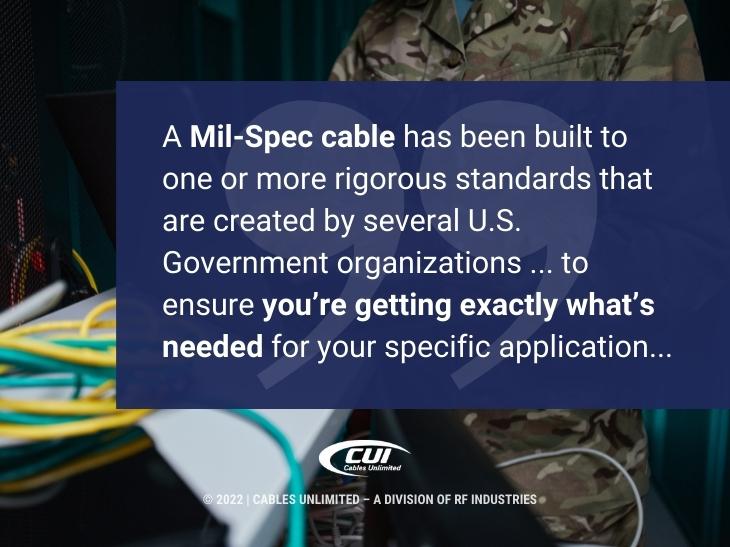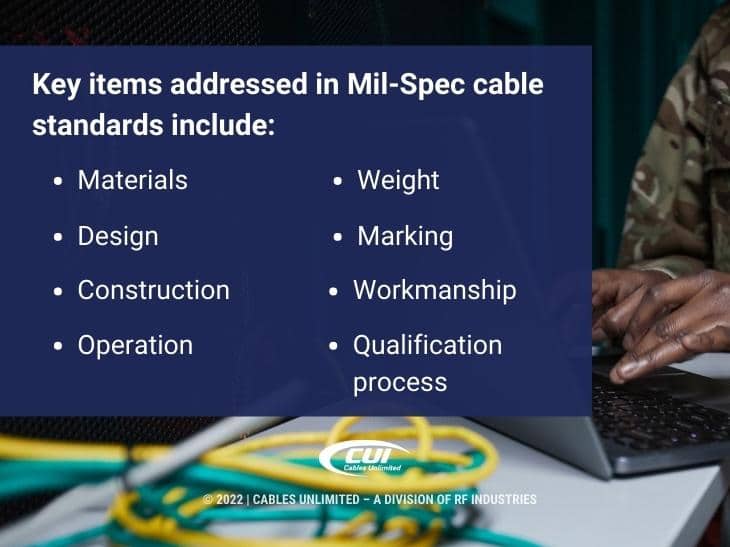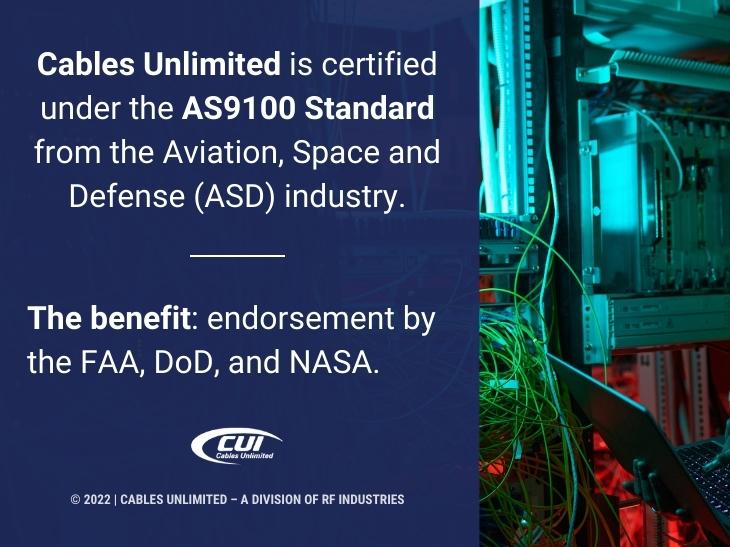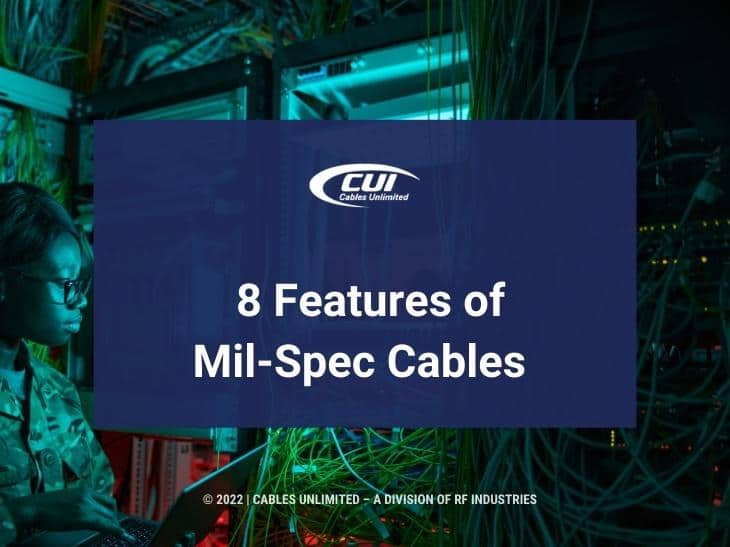In a previous article, we wrote about the importance of quality control when manufacturing military and aerospace cables or Mil-Spec cables. Those cables must meet rigorous quality, strength, and reliability standards. In this article, we touch on the features of Mil-Spec cables and what that means for your applications.
What Is a Mil-Spec Cable?
A Mil-Spec cable has been built to one or more rigorous standards that are created by several U.S. Government organizations. Key items addressed in these standards include materials, design, construction, operation, weight, marking, workmanship, and the qualification process.
Examples of Mil-Spec standards include MIL-C-17 for coaxial cable and MIL-49055 for ribbon cable. Another example is MIL-C 27500 for multi-conductor cables where the RC-06 series has a PTFE tape jacket while the RC-09 has an extruded FEP jacket, and that’s just the start of the specifications.
The list of Mil-Spec cables, covering both fiber optic and copper cables, is quite extensive. Relying on these published standards is an excellent way to ensure you’re getting exactly what’s needed for your specific application without developing the detailed standards yourself.

What Are the Features of Mil-Spec Cables?
Fundamentally, Mil-Spec cables are designed to perform in highly demanding environments. That includes battlefields, jet fighters, missiles, satellites, ships, and submarines. You name the war-fighting equipment, and you’ll find Mil-Spec cables.
Of course, Mil-Spec cables are not restricted to military or aerospace applications. They can be used wherever the following features are critical to equipment operation.
- Absolute Reliability. Every aspect has been specified to maximize the reliability of the cable in the specified environment, from out-of-the-solar system spacecraft to deep-water submarines.
- Harsh Environments. Hot, abrasive, and corrosive are at the start of the list of the types of environments these cables must survive. It’s all built into the specifications and, as a result, the cables themselves.
- Rigorous Standards. The reliability and environmental requirements are a big part of the standards. You can be sure that every single standard specifies exactly what is required for a particular application.
- Qualified Products List. The Department of Defense publishes a database of products that have met the applicable Mil-Spec requirements. That includes the product identification, the qualification reference number, and the manufacturer. This can help streamline your acquisition process.
- Lot Traceability. This is a key feature of not only Mil-Spec cables but general quality assurance procedures. Should a problem be encountered in the field, it can quickly be traced to a specific manufacturing lot. That traceability facilitates isolating and correcting the problem.
- J-STD Soldering Processes. This standard specifies the quality control of solder and soldering practices. It’s a prime example of industry standards and Mil-Spec standards merging to produce a single standard focused on manufacturing processes. It’s one of many, including cable connector crimping, that underly Mil-Spec and high-reliability manufacturing in general.
- Workmanship. The soldering and crimping processes noted above are just two examples of the workmanship requirements. The IPC/Wire Harness Manufacturer’s Association WHMA-A-620 standard details practices and requirements for methods, materials, and tests for cable assemblies. That’s a key aspect of both Mil-Spec and every cable we manufacture.
- Hi-Rel Cable Assembly Test Report. Datasheets are helpful in determining what to expect from a particular cable. But for Mil-Spec work, an actual conformance inspection and test with a detailed report are required for every single cable. That provides assurance that it meets or exceeds the standard.
Read more in our blog: Critical Aspects of Radiation-Hardened Fiber for Military and Aerospace Applications

The Mil-Spec Impact on Your Applications
You rely on Mil-Spec cables to meet your own critical requirements. But you can also be assured that the same rigorous processes used to manufacture to Mil-Spec standards are influencing everything manufactured in that facility.
Not only that but there are many other standards that are used to ensure quality cables for your applications. As just one example, Cables Unlimited is certified under the AS9100 Standard from the Aviation, Space, and Defense (ASD) industry. This standard requires, “creating and maintaining a comprehensive quality system for providing safe and reliable products to the ASD industry.”
Benefits of the certification include the endorsement by all major aerospace regulators including the Federal Aviation Administration (FAA), the US Department of Defense (DoD), and the National Aeronautics and Space Administration (NASA).
Read more in our blog: USA Military Cable Tech: Adapting to Extreme Environments

We Can Help
We produce Mil-Spec fiber optic and copper cable assemblies for a variety of air, navy, ground, and aerospace applications:
- Mil-Spec connectors.
- Mil-Spec cables from quality manufacturers.
- Harsh environmental/tactical/military connectors.
- TFOCA. TFOCA II, 38999, 28876, and standard commercial optical connectors.
- MIL-C 27500 cables and military, aircraft cables.
If your requirements are already specified and ready for a quote, we are ready to meet your deadlines and pricing targets. Our extensive in-house services and advanced manufacturing capabilities are in place to meet your requirements.
But we offer much more than state-of-the-art manufacturing – our dedicated team is also known for going to great lengths to meet the needs of our customers, including working round-the-clock to meet tight turnaround time requirements.
Our sales representatives are standing by to assist you with product questions and quotes Monday – Friday, 8:00 am to 5:00 pm Eastern. You can also send us an email or complete our contact form and we’ll get right back to you.




